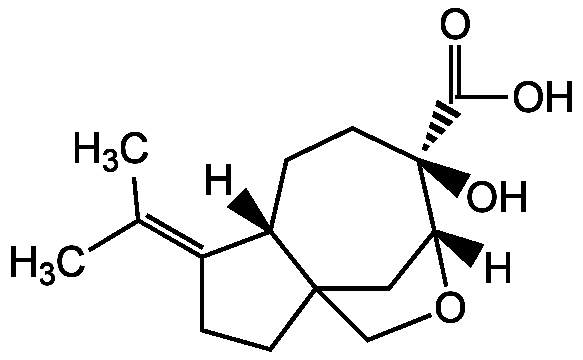Aspterric acid
Product Code: AG-CN2-0132
Product Group: Natural Products and Extracts
Supplier: AdipoGen Life Sciences
| Code | Size | Price |
|---|
| AG-CN2-0132-M001 | 1 mg | £170.00 |
Quantity:
Prices exclude any Taxes / VAT
Overview
Regulatory Status: RUO
Shipping:
Ambient
Storage:
+4°C
Images
Documents
Further Information
Appearance:
White solid.
CAS:
67309-95-9
EClass:
32160000
Form (Short):
solid
GHS Symbol:
GHS07
Handling Advice:
Keep cool and dry.
Hazards:
H302, H312, H332
InChi:
InChI=1S/C15H22O4/c1-9(2)10-3-5-14-7-12(19-8-14)15(18,13(16)17)6-4-11(10)14/h11-12,18H,3-8H2,1-2H3,(H,16,17)/t11-,12+,14?,15+/m0/s1
InChiKey:
IOYVXXQKVQKQIG-ATNWKSFXSA-N
Long Description:
Chemical. CAS: 67309-95-9. Formula: C15H22O4. MW: 266.3. Isolated from Penicillium sp. Antibiotic. Pollen growth and development inhibitor.
MDL:
MFCD24849293
Molecular Formula:
C15H22O4
Molecular Weight:
266.3
Package Type:
Vial
Precautions:
P261, P301, P312, P302, P352, P304, P340
Product Description:
Antibiotic [1]. Pollen growth and development inhibitor [2-4].
Purity:
>95% (HPLC)
Signal Word:
Warning
SMILES:
[H][C@@]12CC3(CCC(=C(C)C)[C@]3([H])CC[C@]1(O)C(O)=O)CO2
Solubility Chemicals:
Soluble in DMSO or methanol. Insoluble in hexane.
Source / Host:
Isolated from Penicillium sp.
Transportation:
Non-hazardous
UNSPSC Category:
Natural Products/Extracts
UNSPSC Number:
12352200
Use & Stability:
Stable for at least 2 years after receipt when stored at -20°C.
References
Aspterric acid, a new sesquiterpenoid of the carotane group, a metabolite from Aspergillus terreus IFO-6123. X-Ray crystal and molecular structure of its p-bromobenzoate: Y. Tsuda, et al.; J. C. S. Chem. Commun. 160 (1978) | Aspterric acid and 6-hydroxymellein, inhibitors of pollen development in Arabidopsis thaliana, produced by Aspergillus terreus: A. Shimada, et al.; Z. Naturforsch. C. 57, 459 (2002) | Interaction between aspterric acid and indole-3-acetic acid on reproductive growth in Arabidopsis thaliana: A. Shimada, et al.; Z. Naturforsch. C. 60, 572 (2005) | The role of aspterric acid in auxin-regulated reproductive growth of Arabidopsis thaliana: A. Shimada, et al.; Z. Naturforsch. C. 63, 554 (2008)



